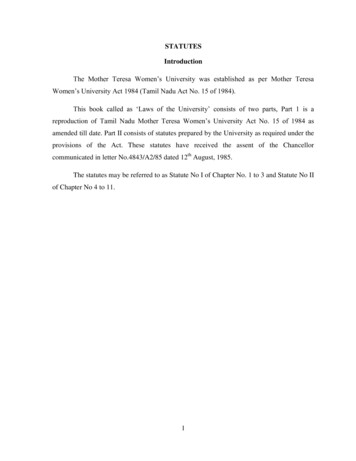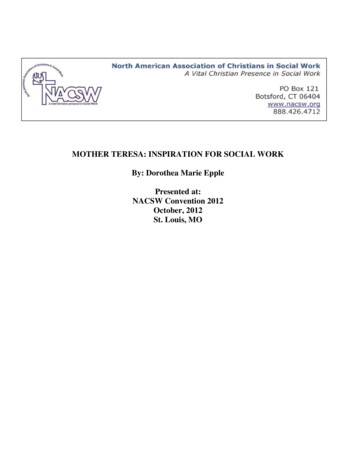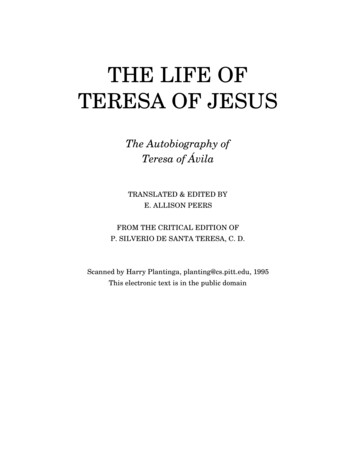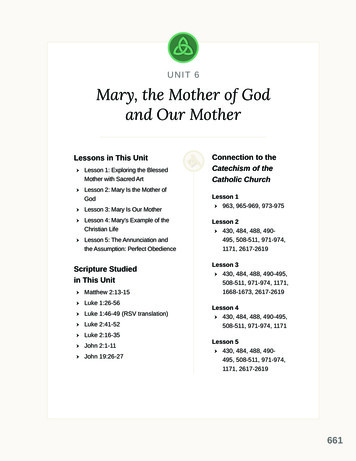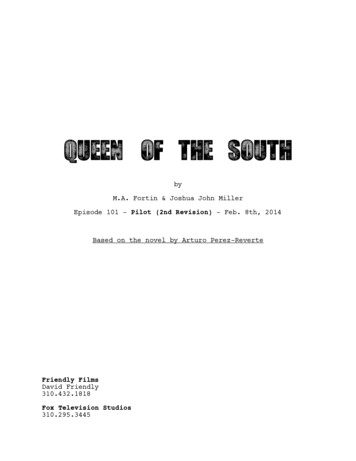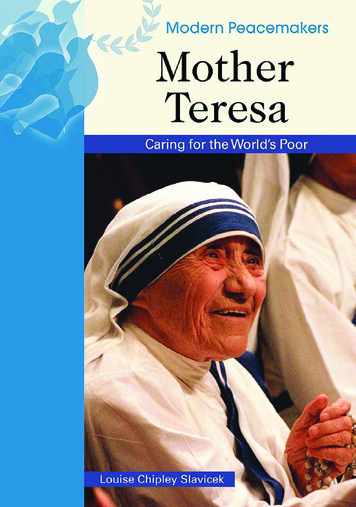
Transcription
Modern PeacemakersMotherTeresaCaring for the World’s Poor
MODERN PEACEMAKERSKofi Annan: Guiding the United NationsMairead Corrigan and Betty Williams:Partners for Peace in Northern IrelandShirin Ebadi: Champion for Human Rights in IranHenry Kissinger: Ending the Vietnam WarAung San Suu Kyi: Activist for Democracy in MyanmarNelson Mandela: Ending Apartheid in South AfricaAnwar Sadat and Menachem Begin:Negotiating Peace in the Middle EastOscar Arias Sánchez: Bringing Peace toCentral AmericaMother Teresa: Caring for the World’s PoorRigoberta Menchú Tum: Activist for IndigenousRights in GuatemalaDesmond Tutu: Fighting ApartheidElie Wiesel: Messenger for Peace
Modern PeacemakersMotherTeresaCaring for the World’s PoorLouise Chipley Slavicek
Mother TeresaCopyright 2007 by Infobase PublishingAll rights reserved. No part of this book may be reproduced or utilized in any formor by any means, electronic or mechanical, including photocopying, recording, or byany information storage or retrieval systems, without permission in writing from thepublisher. For information, contact:Chelsea HouseAn imprint of Infobase Publishing132 West 31st StreetNew York NY 10001ISBN-10: 0-7910-9433-2ISBN-13: 978-0-7910-9433-4Library of Congress Cataloging-in-Publication DataSlavicek, Louise Chipley, 1956–Mother Teresa : caring for the world’s poor / Louise Chipley Slavicek.p. cm. — (Modern Peacemakers)Includes bibliographical references and index.ISBN 0-7910-9433-2 (hardcover)1. Teresea, Mother, 1910–1997. 2. Missionaries of Charity—Biography. 3. Nuns—India—Biography. I. Title. II. Series.BX4406.5.Z8S59 2007271'.97—dc22[B]2006028383Chelsea House books are available at special discounts when purchased in bulkquantities for businesses, associations, institutions, or sales promotions. Please callour Special Sales Department in New York at (212) 967-8800 or (800) 322-8755.You can find Chelsea House on the World Wide Web at http://www.chelseahouse.com.Text design by Annie O’DonnellCover design by Takeshi TakahashiPrinted in the United States of AmericaBang FOF 10 9 8 7 6 5 4 3 2 1This book is printed on acid-free paper.All links and Web addresses were checked and verified to be correct at the time ofpublication. Because of the dynamic nature of the Web, some addresses and links mayhave changed since publication and may no longer be valid.
TABLE OF CONTENTS1 “The Saint of the Gutters”12 Growing Up in a Divided Land73 The Sisters of Loreto234 “A Call Within a Call”385 Becoming an International Figure576 “A Pencil in God’s hy104Further Reading106Index108
CHAPTER1“The Saint ofthe Gutters”On a rainy Saturday afternoon in September 1997, thousandsof mourners—rich and poor, Hindus, Muslims, and Christians alike—lined the streets of Calcutta to watch the city’smost famous resident—Mother Teresa—come home for the last time.As a mark of the esteem in which it held the tiny nun, the Indiangovernment had given Mother Teresa its highest honor: a statefuneral. All over the nation, flags flew at half-mast, and in Calcuttaa three-hour-long Mass was held in the city’s gigantic Netaji IndoorStadium. This service, for the woman popularly known as the Saintof the Gutters, was attended by presidents, prime ministers, queens,and about 15,000 other guests from around the world.After the Mass, the funeral procession slowly wound its waythrough many of the same streets where Mother Teresa had onceministered to the homeless and hungry, finally ending at AcharyaJagdish Chandra Bose Road and the Missionaries of Charity motherhouse. There, at the headquarters of the religious order she hadfounded nearly a half century earlier, the 87-year-old missionary1
2Mother TeresaMother Teresa, shown above in this photograph from 1980, wasfamous for her missions of charity for the poor and disenfranchisedin India and around the globe.
“The Saint of the Gutters”and humanitarian received a private burial, while the crowd thathad gathered outside prayed and wept. As Mother Teresa’s coffinwas placed in the crypt, military honor guards fired a 21-gunsalute—an odd tribute for the Nobel Peace Prize laureate, whoobjected to war and violence in any form.Mother Teresa was born in Eastern Europe to Albanian parents, shortly before the outbreak of World War I. She first cameto India as a missionary nun with the Catholic Loreto Order,when she was still a teenager. For nearly two decades, she liveda secluded and relatively comfortable life, teaching geographyto middle- and upper-class Indian girls in the vast Loreto compound in Calcutta. On her few forays out of the gated complex,Teresa was stunned by the desperate poverty in the squalid neighborhoods that lay just beyond the convent walls.In 1946, while traveling to the Loreto convent in Darjeeling,India, Mother Teresa’s life changed forever. She heard God calling her to work and live among the destitute and forgotten men,women, and children who inhabited Calcutta’s teeming slums. Ittook nearly two years for Mother Teresa to secure the CatholicChurch’s permission to abandon her cloistered lifestyle as a LoretoSister and begin her mission of mercy in the streets of India’smost populated city. In 1950, the Vatican officially recognized thesmall band of women—many of them former pupils—who hadgathered around Mother Teresa as a new order: the Missionariesof Charity. For the next 47 years, Mother Teresa, assisted by hersari-clad Sisters, founded scores of schools, medical dispensaries,orphanages, and homes for the dying. They worked first in Calcutta, then throughout India, and by the late 1960s, in cities andtowns all over the world. In the process, Mother Teresa becamean international celebrity, a symbol of compassion and hope forpeople of all religious and ethnic backgrounds.In recognition of her tireless efforts on behalf of the world’sneedy and unwanted, Mother Teresa received numerous honorsduring her lifetime, none as prestigious as the Nobel Peace Prize,granted by the Norwegian Nobel Committee in 1979. It may seem3
4Mother TeresaHistory of the Nobel Peace PrizeThe most famous and prestigious peace prize in the world, theNobel Peace Prize, was named for Swedish chemist, engineer,and inventor Alfred B. Nobel. Born in Stockholm in 1833, Nobel’sclaim to fame was his invention of the powerful but relatively safeexplosive, dynamite.Upon his death in December 1896, Alfred Nobel bequeathed thevast bulk of his fortune to the establishment of the Nobel Foundation. The foundation would be responsible for awarding annualprizes to individuals or organizations whose endeavors duringthe past year had most benefited humanity. The prizes, each ofwhich came with a substantial cash award, were to be granted infive areas: literature, chemistry, physics, physiology or medicine,and peace. (In 1969, a sixth prize, for economics, financed by theSwedish National Bank, was added.)All of the prizes, with the exception of the peace prize, were tobe granted by Swedish committees. In his will, Nobel directed thatthe peace prize be awarded by a five-person committee appointedby the Norwegian Storting, or Parliament. No one knows for surewhy Nobel assigned responsibility for granting the peace prize toa Norwegian rather than a Swedish committee. The inventor mayhave been influenced by the fact that the government of Norway,which at the time of his death was in a union with Sweden under acommon king, had a reputation for supporting nonviolent solutionsto international disagreements. Although Nobel never stipulatedthat the members of the committee be Norwegian nationals, todate all committee members have been.According to Nobel’s will, the prize for peace was to be given tothat person or group who “shall have done the most or the bestwork for fraternity between nations, for the abolition or reduction ofstanding armies and for the holding of peace congresses.” In contrast to the other Nobel prizes, the Peace Prize may be granted toindividuals or organizations that are still in the process of resolvinga problem rather than solely upon the resolution of that problem.The awarding of the Nobel Peace Prize on December 10 (theanniversary of Nobel’s death in 1896) is the result of a lengthy
“The Saint of the Gutters”5process. Nominations must be turned in to the Norwegian Nobelcommittee by February 1 of each year. Only certain individualsmay nominate candidates for the prize, including current andpast members of the committee, international judges, members of national governments and assemblies, Nobel PeacePrize laureates, and university professors of history, philosophy, political science, and law. The committee might receive asmany as 200 nominations in a single year. After the committeecreates a “short list” of nominees, the candidates are reviewedby permanent advisers as well as advisers specially appointedfor their knowledge of particular nominees. Around October1, the Peace Prize winner or winners are selected through amajority vote. The new laureate’s name is usually announced inOslo soon after that.The first Nobel Peace Prizes were granted in 1901, five yearsafter Alfred Nobel’s death. Up to three Nobel Peace Prize laureatesmay be selected in a single year, and in 1901 two men shared thehonor and the award money that went with it. One was FrédéricPassy of France, the founder and president of the first Frenchpeace society and chief organizer of the Universal Peace Congress, an international body dedicated to promoting peace. Theother was Jean Henry Dunant of Switzerland, the founder of theRed Cross and the guiding light behind the Geneva Convention, aseries of international agreements establishing rules for nations atwar, including treatment of civilians, prisoners of war, the wounded,and the sick.The many outstanding individuals selected by the Nobel committee to receive the Peace Prize since 1901 include U.S. presidents Woodrow Wilson and Jimmy Carter, German humanist andmissionary doctor Albert Schweitzer, African-American civil rightsactivist Martin Luther King Jr., and Russian human rights advocateAndrei Sakharov. The twentieth century’s most celebrated advocate of nonviolence, Mohandas Gandhi (1869–1948), was nominated five times for the prize but never received it. Many attributethis oversight to racial prejudice.
6Mother TeresaHilary Rodham Clinton (left), at the time the First Lady of the UnitedStates, bows her head as Indian soldiers carry Mother Teresa’s casketinto the Netaji Indoor Stadium in Calcutta.surprising that someone who had no formal involvement in politics or diplomacy should have been chosen for this distinguishedaward. The Norwegian Nobel committee, however, has a long tradition of honoring those who strive to overcome poverty, hunger,and social injustice in the world, all of which they view as gravethreats to peace, both within and among nations.Today, a decade after Mother Teresa’s death, the order shefounded remains as dedicated as ever to advancing the cause ofworld peace through works of compassion and love. From Indiato Italy, San Francisco to Santiago, the Sisters of the Missionariesof Charity continue Mother Teresa’s selfless commitment to servethe world’s suffering and forsaken and to uphold the dignity andvalue of all people.
CHAPTER2GrowingUp in aDivided LandThe woman who came to be known as Mother Teresa was bornAgnes Gonxha Bojaxhiu on August 26, 1910, in the town ofSkopje, in southeastern Europe’s Balkan Peninsula. Today,Skopje is the capital of the Republic of Macedonia, but in 1910, thetown was part of Turkey’s far-ranging—and rapidly disintegrating—Ottoman Empire. Agnes; her older brother, Lazar; her sister, Age (orAga); and their parents, Nikola and Drana Bojaxhiu, were ethnicAlbanians and Roman Catholic Christians, and they were in theminority in Skopje. At the turn of the twentieth century, the city’sinhabitants were chiefly Eastern Orthodox Christians of Serbiandescent. The Bojaxhius’ status as a double minority in their ethnically and religiously divided hometown would have a profoundeffect on young Agnes during her early years.TUMULTUOUS TIMES FOR ALBANIANSThe year of Agnes Bojaxhiu’s birth was a tumultuous one forAlbanian people on the Balkan Peninsula. Ever since their western7
8Mother TeresaBalkan kingdom fell to the Ottomans in the fifteenth century,ethnic Albanians dreamed of rebuilding an independent Albania. Albanians trace their roots back to the ancient Illyrians,who once inhabited the present-day Republic of Albania. Theyalso lived in much of the former Ottoman vilayet (“province”)of Kosova, to the Republic’s east, an area currently dividedbetween Serbia and Macedonia. Encouraged by the steadyweakening of the once-mighty Ottoman Empire during the latenineteenth and early twentieth centuries, Albanian nationalistsstaged their first major uprising against their longtime rulers inMarch 1910.Centered in Kosova, the uprising of 1910 erupted in the townof Pristina. Soon the rebellion had spread throughout the vilayet(or province), where ethnic Albanians were in the majority, withthe exception of a few isolated areas, such as the Bojaxhius’hometown of Skopje. By the end of the summer, an Ottomanforce of 20,000 troops had managed to quell the uprising. TheOttomans suppressed the revolt with excessive brutality: Theyburned down entire villages and conducted public whippingsof rebel leaders, which served to strengthen the resolve of theAlbanian freedom fighters.By 1912, Albanians found themselves confronting a dangerous new opponent in their ongoing quest for a state of their own.As the Ottoman Empire continued to weaken during the yearsleading up to World War I (1914–1918), other Balkan nationssought to grab Turkey’s European possessions for themselves.Hungry for more territory and for access to the Adriatic Sea, Serbia was especially interested in acquiring Kosova and northernAlbania. In the summer of 1912, Serbian troops and their Balkanallies invaded Kosova, pillaging and plundering dozens of Albanian towns and villages as they pushed southward.Within a few months, Serbian forces occupied most of thevilayet and were close to expelling the Ottomans from the BalkanPeninsula. Worried that their Slavic neighbor to the south wasbecoming too powerful, the leaders of the Austrian-Hungarian
Growing Up in a Divided LandThis map shows the boundaries of the Balkan nations as theyappeared before World War I. Mother Teresa’s birthplace, Skopje,is labeled as “Uskub,” the Turkish name for the Macedonian town.9
10Mother TeresaEmpire sought to prevent Serbia from annexing all of Albania.To that end, in November 1912, Austria-Hungary and the other“Great Powers” of Europe, including France, Great Britain, andGermany, formally backed the creation of an independent Albanian state along the Adriatic coastline.ETHNIC VIOLENCE IN KOSOVAAlbanians throughout the Balkans were elated at the formationof the new Albanian state. In Kosova, however, the rejoicing wassoon replaced by terror, as the occupying Serbian troops turnedviciously on the province’s Albanian residents. While the leadersof the Great Powers debated the future of Kosova among themselves, Serbian atrocities against Albanian Kosovars increased,and thousands of men, women, and children were slaughtered.According to some, the escalating violence in Kosova wasmotivated by more than ethnic and religious prejudice: The killings were also spurred by a desire to decimate the province’s Albanian population. Rumor had it that the Great Powers intended togive the new Albanian state those portions of Kosova in whichethnic Albanians held a substantial majority, and Serbian leaders were grimly determined to hold onto as much of the formervilayet as possible. “The [Serbian] massacres are taking place forstatistical purposes,” a British diplomat in Kosova alleged in 1913.“I am beginning to suspect that much of the Albanian populationis being murdered in cold blood.”1Horrific stories of Serbian barbarity against Albanian Kosovars soon began to trickle out of the beleaguered province. InPristina, 5,000 ethnic Albanians were allegedly roped togetherand mowed down by Serbian machine-gun fire on a single dayin late 1912. Agnes’s hometown of Skopje was also the site ofnumerous purported atrocities. According to some eyewitnessaccounts, Serbian troops raped, tortured, or murdered hundredsof the town’s Albanian residents, slaughtering even infants andyoung children.
Growing Up in a Divided LandA PROSPEROUS AND CLOSE-KNIT FAMILYThe Bojaxhius had to have been generally aware of the ethnicviolence in Skopje and Kosova during the years leading up toWorld War I. The precise impact of the turmoil on young Agnesand her family, however, like so many details of Mother Teresa’searly life, is shrouded in mystery. Over the years, Mother Teresaconsistently refused to discuss her childhood or family in anydetail. Her personal life, she insisted, was of no importance. Whatreally mattered was her missionary and charitable work, and thatwas all she wanted to talk about.What little information biographers have been able to gatherabout Mother Teresa’s early childhood indicates that her familywas financially comfortable and close knit. Her father, NikolaBojaxhiu, was a successful investor, building contractor, andinternational merchant, who spoke four languages in additionto his native Albanian. He owned several valuable properties inthe Skopje area. Surrounded by fruit trees and flower gardens,the house that he, his wife, and their three children lived in waselegant and spacious; it even included separate guest quarters.Nikola Bojaxhiu, or Kole, as he was generally known, was notonly an excellent provider but also an affectionate and attentivefather and husband. He was frequently away from Skopje on business, and whenever he was expected home, his family was filledwith joyful anticipation, Lazar Bojaxhiu recalled. Decades later,Lazar still remembered fondly how his father could always becounted on to bring back small gifts for his wife and each of thechildren and to entertain them with exciting and often humorousaccounts of his travels.HER MOTHER’S DAUGHTERDrana Bojaxhiu, although devoted to her husband, was decidedlymore serious than her sociable and fun-loving husband. One ofthe few stories Mother Teresa ever related about her early childhood highlights her mother’s no-nonsense style and disdain for11
12Mother Teresawaste of any sort—character traits that the famous missionaryherself would display throughout her adult life. One evening,when their father was out of town on a business trip, Teresarecalled, the Bojaxhiu children lingered at the dinner table, swapping jokes and silly stories. Their mother listened for a while,then quietly left the room. Suddenly the entire house was plungedinto darkness: Drana Bojaxhiu had shut off the main powerswitch. “She told us that there was no use wasting electricity sothat such foolishness could go on,” Mother Teresa explained to abiographer.2According to Lazar Bojaxhiu, it was clear from the time shewas very young that Agnes, much more than either of her twosiblings, was her mother’s child. Agnes was not only naturallyobedient but also unusually serious for her age, he remembered.For instance, whenever young Lazar gave in to temptation andstole jam from the pantry, Agnes could be counted on to give herolder brother a stern lecture. To his relief, however, she never toldtheir parents what had happened.Lazar Bojaxhiu also remembered that his younger sisterinstructed him about the importance of treating persons ofauthority—and especially church officials—with respect. DuringAgnes’s early childhood, the priest at the Church of the SacredHeart, the local Catholic parish, was a severe disciplinarian, withrigid ideas regarding how children should behave. Young Lazarand his friends heartily disliked the ill-tempered priest and oftencomplained about him behind his back. When Lazar criticizedthe cleric in front of Agnes, however, she was dismayed and didnot hesitate to express her disapproval to her older sibling: “It isyour duty to love him and give him respect,” she scolded. “He isChrist’s priest.”3TRAGEDY STRIKES THE BOJAXHIU FAMILYShortly before Agnes turned four years old, World War I eruptedin Europe, pitting the Allies—Serbia, Russia, France, Belgium, andGreat Britain—against the Central Powers of Austria-Hungary,
Growing Up in a Divided LandGermany, Turkey, and Bulgaria. Throughout most of the morethan four-year-long conflict, Kosova was occupied by Bulgarianand Austrian troops, bringing a halt to Serbian atrocities againstthe province’s Albanian population. Following the Allied victory inNovember 1918, the authors of the Treaty of Versailles took it uponthemselves to redraw the map of southeastern Europe. Accordingto the terms of the peace treaty, the Bojaxhius’ hometown andprovince were annexed to the newly created Kingdom of the Serbs,Croats, and Slovenes known from 1929 until 1992 as Yugoslavia.In 1992, Yugoslavia became the independent republics of Slovenia,Macedonia, Montenegro, and Bosnia.Governed from the city of Belgrade on the Danube River,this new kingdom was overwhelmingly Slavic; ethnic Albanianslike Agnes and her family made up only a small fraction of thecountry’s 12 million inhabitants. Within the province of Kosova,however, Albanians still remained the single largest ethnic group.Consequently, many Albanian Kosovars believed that theirregion should be allowed to leave the new federation created bythe Versailles Treaty, to become part of what they referred to as a“Greater Albania.”Kole Bojaxhiu was a passionate supporter of Albanian independence. After World War I, he became heavily involved in themovement for a Greater Albania. His devotion to the cause was sostrong that, in 1919, he traveled more than 150 miles northwardto Belgrade to attend a political gathering for Albanian Kosovarswho wanted their region to be incorporated into Albania. To hisfamily’s horror, late one evening, a few days after Kole had set offfor the Yugoslavian capital, the previously healthy 45-year-oldreturned home in the carriage of the local Italian consul, barelyconscious and obviously on the brink of death. Determined thather husband should receive the last rites of the Catholic Churchbefore he died, Drana ordered nine-year-old Agnes to fetch theparish priest as quickly as possible.When she could not track down the local priest at the churchor rectory, Agnes decided to go to the Skopje railway station.Apparently, someone told her that a Catholic cleric who was13
14Mother Teresapassing through the area had just been spotted there. Rushing tothe station, Agnes persuaded the unkown priest to come homewith her, where he administered the last rites to Kole and prayedwith the frightened family. Forty-eight hours later, Kole was dead.Even today, the cause of his illness and rapid demise remains amystery. Many years after the tragedy, however, Lazar Bojaxhiurevealed to an interviewer that he blamed the Yugoslavian government for his father’s untimely death. Government agents hadsecretly poisoned Kole while he was attending a political dinnerin Belgrade, Lazar theorized, because of his father’s involvementin the campaign to take Kosova away from Yugoslavia.DRANA RISES TO THE OCCASIONDrana Bojaxhiu was devastated by the sudden loss of her husband.In her grief, she withdrew from her family, relying on 15-year-oldAge to run the household and watch the younger children for her.Drana’s despair only grew when her husband’s former businesspartner stole Kole’s share of the earnings and then disappeared,leaving the Bojaxhius all but penniless.Several months after Kole’s death, however, Drana finally beganto pull herself together. Realizing that she had no choice but tobecome the family’s breadwinner, she set up a small business of herown, selling embroidered cloth and other locally crafted textiles.Soon she had expanded her business to include the hand-woven rugsfor which Skopje was famous throughout the Balkans. The familywould never again attain the level of prosperity they had enjoyedwhile Kole was alive, but thanks to Drana’s initiative and hard work,they always had a roof over their heads and food on their table.All her life, Drana had been deeply religious, but now morethan ever she turned to her faith and her church to guide andsustain her. Every evening, she and the children prayed together,and most mornings they attended Catholic Mass at the nearbyChurch of the Sacred Heart. Drana also encouraged her childrento take part in a wide range of church activities. She realized that
Growing Up in a Divided Landthe close-knit, predominantly Albanian parish not only providedthe Bojaxhiu children with vital spiritual and emotional support,but also with a sense of cultural and religious identity in a townwhere they were significantly outnumbered by Slavs and EasternOrthodox Christians. Even within the Albanian community, theBojaxhius were in the minority: Most Albanians had abandonedCatholicism in favor of the Islamic faith of their Ottoman conquerors centuries earlier. In fact, during the early 1900s, onlyabout 25 percent of Kosova’s Albanian population was Catholic,and even less—perhaps as little as 10 percent—of the populationof the nation of Albania was Catholic.“ALL OF THEM ARE OUR PEOPLE”The Bojaxhiu family had long been known in Skopje for theirgenerosity toward the town’s poor and downtrodden. Kole Bojaxhiu, a firm believer in the importance of Christian charity, madea point of opening his dinner table to the Bojaxhius’ less fortunateneighbors. “Never eat a single mouthful unless you are sharing itwith others,” he often admonished his children.4 Drana Bojaxhiu,who shared her husband’s strong commitment to assisting anyone in need, regularly took food, clothing, and other items to thedestitute and sick of the parish. Mother Teresa recalled that hermother never broadcast her good deeds, however: “When you dogood, do it unobtrusively, as if you were tossing a pebble into thesea,” Drana liked to say.5After Kole’s death, the Bojaxhiu home continued to be arefuge for the hungry and forgotten. Although there was far lessmoney to spare in the household than when her husband hadbeen alive, Drana still opened the family dinner table to anyonein need, from distant relatives to complete strangers. Years later,Lazar remembered asking his mother about the steady stream ofguests who shared their meals, most of whom he had never metbefore. “Some of them are relations,” she answered, “but all ofthem are our people.”615
16Mother TeresaNow and then, Drana would invite a destitute or ill townsperson into her home for an extended period of time. After hisyounger sister’s charitable work in India had made her an international celebrity, Lazar Bojaxhiu told an interviewer:I remember how my mother once heard about a poor womanfrom Skopje, who was suffering from a tumor. She had nobodyto look after her. Her family didn’t want to have anything to dowith her; they refused to help her in any way and threw her out,all because of some trivial business. My mother took her in, fedher, and cared for her till she was cured. So you see, “MotherTeresa” didn’t just suddenly show up out of nowhere.7STUDENT, MUSICIAN, AND WRITERBy the mid 1920s, Agnes Bojaxhiu had grown into an outgoingand self-assured teenager. Slender and unusually petite at just fivefeet tall, she was an attractive girl with dark hair and deep-setbrown eyes. Her older brother remembered her as bright and wellspoken, “always sure of herself, sharp, never at a loss for words,and afraid of nobody.”8 Agnes was an outstanding student whogenuinely loved learning. After receiving her early education inthe Albanian language at a private Catholic school, she attended apublic high school, or “gymnasium,” where all classes were taughtin Serbo-Croatian, as was mandatory for state-supported schoolsin Yugoslavia at that time. Drana Bojaxhiu evidently held moreprogressive views regarding female education than most of herneighbors; unlike the vast majority of Albanian girls in Skopje,both of her daughters continued their public schooling throughthe twelfth grade.Agnes was not only one of the top students in her class atthe gymnasium—she was also a talented musician. She playedboth the accordion and the mandolin, a small stringed instrument with a straight neck and pear-shaped body. In addition, shewas also blessed with a rich soprano voice and enjoyed singing.
Growing Up in a Divided Land17Above, a church steeple rises next to a mosque’s minarets in the oldpart of Skopje, Macedonia. The Bojaxhiu family was a minority in Skopjebecause of their Catholic faith and Albanian descent—most of their fellow townspeople were Eastern Orthodox Christians of Serbian descent.
18Mother TeresaThroughout her high-school years, Agnes belonged to the localparish choir and the Albanian Catholic Choir of Skopje, oftenperforming duets with her sister, Age.Another of Agnes’s favorite pastimes during her teen yearswas writing. She penned two articles that appeared in the localAlbanian-language newspaper, Blagovest, during the late 1920s.Although Agnes clearly had a talent for journalistic writing, hertrue passion was poetry. According to biographer Eileen Eagan,“she often carried a notebook with her and on occasion wouldread to her friends the poetry she had written.”9FATHER JAMBREKOVIC AND THE CATHOLICMISSIONS IN INDIAThroughout her adolescence, Agnes was active in the Church ofthe Sacred Heart. Indeed, Lazar Bojaxhiu would later muse thatthe parish church was his younger sister’s second home. Agnes’sgrowing involvement in the church coincided with the arrival ofFather Franjo Jambrekovic as Sacred Heart’s new parish priest in1925. A charismatic Jesuit priest with a knack for communicatingwith young people, Jambrekovic made it a point to reach out tohis teenaged paris
gathered around Mother Teresa as a new order: the Missionaries of Charity. For the next 47 years, Mother Teresa, assisted by her sari-clad Sisters, founded scores of schools, medical dispensaries, orphanages, and homes for the dying. They worked first in Cal-cutta, then throughout India, an
